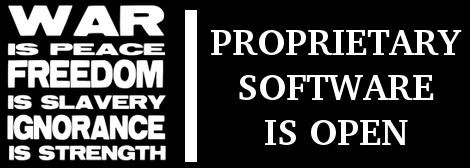

FOR well over a month we've written Openwashing Reports every weekend. Eventually we might have lots of examples we can cluster together based on common themes. Eventually we may get a list or a 'catalogue' of openwashing patterns that can be presented concisely in a wiki page. This is work in progress. This weekend we’ve split the Openwashing Report into 4 parts. We also have a guest contributor to this series. There's growing interest in the subject, particularly in light of events like Stallman's 'exit'. There an upsurge of "Open Core" a.k.a. "Enterprise Edition" etc. (dual-licensing) and we need to keep up with these emergent threats, at the very least by explaining them.
"Eventually we may get a list or a 'catalogue' of openwashing patterns that can be presented concisely in a wiki page.""Open Source" in 2019 does not mean what it meant in 2009 and in 1999. The de facto definition or what people perceive it to be changes over time. According to the Linux Foundation, which is no longer about Linux, Microsoft is king.
Sometimes "open source" means nothing; sometimes it means Microsoft's proprietary software. Sometimes 'open source' comes to mean just "something you can replace", as in this new example ("Teams to discuss ‘open source’ parts idea for 2021").
Readers question what they nowadays read about "open source" or "open-source" or "Open Source". As one reader put it: "Is this open source? ("Open-source" parts proposed as F1 standardisation alternative by Adam Cooper)
"Sometimes "open source" means nothing; sometimes it means Microsoft's proprietary software""The FIA has proposed an “open-source” alternative..."
“I think it’s a really good idea, where teams publish their design on the FIA website and all teams can see what they’re using and pick and choose the bits that they want to."
From the article: "The FIA has proposed an “open-source” alternative to standard Formula 1 parts for 2021 that would see teams sharing their designs for certain elements of the car.
"The governing body has been keen to introduce standard parts as cost-saving measure, with several items having gone to tender."
That's an odd slant on what Open Source originally meant, either in the intelligence context or software. Notice how they use scare quotes around “open-source” and add a dash. They know that they're 'torturing' this term.
Our reader had caught this before we did. Some readers report this stuff to us. They're not too happy.
"Notice how they use scare quotes around “open-source” and add a dash. They know that they're 'torturing' this term."Surveillance code is being spun as "open", war is being marketed as "open", and here's a new example from Google ("Google simplifies open-source software with Cloud Dataproc on Kubernetes").
One of the more troubling patterns we've come across is "open" code that cannot run freely. "Open" but runs only on proprietary platforms? Apparently that has become rather common, especially on iOS and Windows. If your so-called 'open' stuff requires proprietary software to merely execute, then you must be wasting your time developing it. How about "Exadel Launches Adobe Experience Manager Authoring Toolkit as Open Source Tool for Digital Marketing Community"? Adobe is a foe of Software Freedom; why not support the Free software alternatives to it? To quote: "The Toolkit supports an automatic yet versatile and extendable generation of UI elements for AEM authors and provides a next-gen authoring experience in Adobe’s Coral UI-powered environment."
But it's proprietary. So the code basically steers people away from freedom.
"It's unfortunate to see that a lot of so-called 'open' programs are designed to run only under Windows. What is being accomplished?"Here's another new example of so-called 'open' code that runs only on proprietary software, Windows, with its back doors (the protocol itself and the operating system). The headline says "New open source tool helps prevent brute force and ransomware attacks". It's called Cameyo and it is also hosted by Microsoft (GitHub, the proprietary software trap), which puts the NSA back doors in there in the first place. What good is 'security' software on top of a platform designed to not be secure? Here's another new example. It's so-called 'Open-Source' which has neither source code (for now) nor disclosure date and can only run on Windows with NSA back doors. What kind of farcical security can this thing really offer? And here's a third new example, MobaXterm. What good is an SSH client that only runs on a platform with NSA back doors? Users expose private keys etc.
Things to look out for nowadays aren't just the licences but also supported platforms. It's unfortunate to see that a lot of so-called 'open' programs are designed to run only under Windows. What is being accomplished? ⬆
"I would love to see all open source innovation happen on top of Windows."
--Steve Ballmer, Microsoft CEO